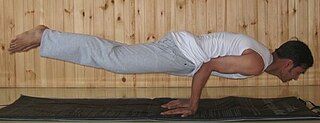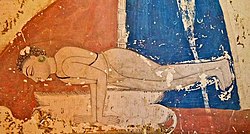Mayurasana
Hand-balancing posture in hatha yoga From Wikipedia, the free encyclopedia
Mayūrāsana (Sanskrit: मयूरासन) or Peacock pose[1] is a hand-balancing asana in hatha yoga and modern yoga as exercise with the body held horizontal over the hands. It is one of the oldest non-seated asanas, described in the 10th century.

Etymology and origins

The name comes from the Sanskrit words mayūra (मयूर) meaning "peacock"[2] and āsana (आसन) meaning "posture".[3]
Mayurasana is one of the oldest non-seated asanas used in hatha yoga; it is first described in the 10th century Vimānārcanākalpa. The Vāsiṣṭha Saṁhitā 1.76-7 states that it destroys all sins.[4]
Description
In this asana the body is raised like a horizontal stick holding the floor with both palms while the body is supported by the elbows.[5]
Variations
Hamsasana (Swan Pose) is identical to Mayurasana except that the hands are placed with the fingers pointing forwards.[6]
Padma Mayurasana (Lotus in Peacock Pose) has the legs crossed as in Lotus Position.[7]
- Padma Mayurasana
See also
- List of asanas
- Planche (exercise)
- Vrischikasana, scorpion pose, with variations including Pincha Mayurasana
References
Sources
External links
Wikiwand - on
Seamless Wikipedia browsing. On steroids.


